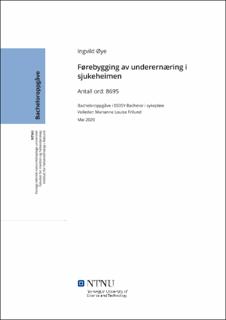| dc.contributor.advisor | Frilund, Marianne Louise | |
| dc.contributor.author | Øye, Ingvild | |
| dc.date.accessioned | 2020-07-07T16:08:43Z | |
| dc.date.available | 2020-07-07T16:08:43Z | |
| dc.date.issued | 2020 | |
| dc.identifier.uri | https://hdl.handle.net/11250/2661259 | |
| dc.description.abstract | Samandrag
Bakgrunn
20-60% av eldre som mottek helsetjenester i kommunen, er underernærte eller i risiko for å utvikle underernæring. Næring og væske er eit grunnleggande behov, og god ernæring er ein føresetnad for at eldre skal kunne bevare god helse og god livskvalitet. Temaet for oppgåva er korleis sjukepleiar kan førebygge underernæring i sjukeheim.
Hensikt
Litteraturstudien si hensikt var å finne ut korleis sjukepleiar kan førebygge underernæring i sjukeheim, som igjen kan bidra til at eldre får styrka livskvalitet og helse.
Metode
Oppgåva er ein systematisk litteraturstudium. Den er basert på åtte forskingsartiklar der fire av dei har brukt kvalitativ og tre har brukt kvantitativ forskingsmetode. Ein artikkel er basert både på kvalitativ og kvantitativ forskingsmetode.
Resultat
Resultata blei delt inn i tre hovudkategoriar: Ernæringskompetanse, sjukepleiaren sine prioriteringar og tverrprofesjonelt samarbeid- involvering av ulike profesjonar og pasienten. Ernæringskompetansen til sjukepleiarane kunne vore betre, og utvikling av ernæringskompetansen var positivt for vidare ernæringsarbeid. Ernæringspleie blir i mange tilfelle nedprioritert til fordel for andre sjukepleieoppgåver. Pasienten føler seg ikkje alltid involvert i ernæringsarbeidet og får ikkje alltid bidrege til vala som blir teke. Samtidig viser funna at eit godt samarbeid med ein fast sjukeheimslege er positivt for sjukepleiaren i vanskelege ernæringssituasjonar.
Konklusjon
Det er fleire strategiar som sjukepleiar kan ta i bruk for å førebygge underernæring i sjukeheim. Å heve ernæringskompetansen er kanskje den viktigaste. Sjukepleiaren bør ha større fokus på å prioritere ernæringspleie og pasientar som er i risiko for underernæring. Samtidig er eit godt samarbeid mellom sjukepleiar, lege og pasient viktig for å kunne oppnå eit felles mål, og for å førebygge at pasienten blir underernært. | |
| dc.description.abstract | Abstract
Background
20-60% of the elderly who receive community health services are malnourished or at risk of developing malnutrition. Nutrition and fluids are a basic need, and good nutrition is a prerequisite for the elderly to maintain good health and a good quality of life. The theme of the assignment is how nurses can prevent malnutrition in nursing homes.
Purpose
The purpose of the literature study was to find out how nurses can prevent malnutrition happening to patients in nursing homes, which in turn can help the elderly to strengthen their quality of life and health.
Method
The assignment is a systematic literature study. It is based on eight research articles, where four of them have used qualitative and three have used quantitative research methods. One article is based on both qualitative and quantitative research methods.
Results
The results were divided into three main categories: Nutrition competence, the nurse's priorities and cross-professional collaboration involving various professionals and the patient. Nutrition skills for nurses could be improved, and development of nutritional competence was positive for further nutritional work. Nutrition care is in many cases prioritized for the benefit of other nursing tasks. The patient does not always feel involved in the nutritional work and does not always have to contribute to the vala that becomes tick. At the same time, finding that a good collaboration with a permanent home physician shows positive for the nurse in difficult nutritional situations.
Conclusion
There are several strategies that nurses can use to prevent malnutrition in nursing homes. Raising nutritional competence is perhaps the most important. Nurses should have a greater focus on prioritizing nutritional care and patients at risk for malnutrition. At the same time, good collaboration between the nurse, doctor and patient is necessary in order to achieve a common goal, and to prevent the patient from becoming malnourished. | |
| dc.publisher | NTNU | |
| dc.title | Førebygging av underernæring i sjukeheimen | |
| dc.type | Bachelor thesis | |
